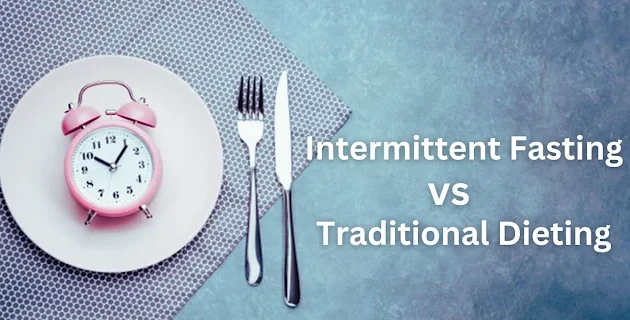If you’re looking to lose weight and improve your health and overall wellness, you may have come across Intermittent Fasting vs Traditional Dieting as options for your weight-loss journey. But which one is more effective? That’s what we’re here to find out.
Intermittent Fasting
First, let’s start with an explanation of Intermittent Fasting. Intermittent Fasting is a pattern of eating that involves alternating periods of eating and fasting.
It can be done in many ways, such as the 16/8 method involves fasting for 16 hours and eating within an 8-hour window. Or the 5:2 method, where you usually eat five days a week and restrict calories for the other two days.
Intermittent Fasting has been shown to have many health benefits, such as weight loss, improved insulin sensitivity, and increased longevity.
Traditional Dieting
On the other hand, Traditional dieting is a more conventional approach to weight loss. It typically involves cutting calories, counting points, or following a specific meal plan.
It’s a more structured approach to weight loss, where you’re consistently eating less. Traditional dieting also has benefits, such as weight loss, improved nutrient intake, and increased energy levels.
In this article, we’ll be comparing and contrasting the effectiveness of Intermittent Fasting vs Traditional Dieting. We’ll look at similarities and differences, which is more effective for weight loss, and which is more sustainable for long-term weight management.
By the end of this article, you’ll better understand which approach may be best for you and your weight loss journey.
Intermittent Fasting vs Traditional Dieting: Which is More Effective?
Intermittent Fasting: how it works, the benefits and potential downsides
Intermittent Fasting is a pattern of eating that involves alternating periods of eating and fasting. It’s a way of eating that has been gaining popularity recently, and for a good reason. It’s simple, flexible, and has been shown to have many health benefits.
When it comes to intermittent fasting, it’s all about timing. The most popular method is the 16/8 method, where you fast for 16 hours and eat during an 8-hour window.
For example, if you finish your last meal at 7 pm, you will eat again at 11 am the next day. By restricting your eating time, your body can burn stored energy (fat) for fuel.
One of the most significant benefits of Intermittent Fasting is weight loss. By restricting your eating time, you’re also limiting the number of calories you’re consuming. This calorie restriction leads to weight loss.
Intermittent Fasting has also been shown to improve insulin sensitivity, leading to better blood sugar control and a lower risk of type 2 diabetes. Additionally, Intermittent Fasting has been linked to increased longevity and overall health.
As with anything, there are potential downsides to Intermittent Fasting. For some, sticking to the eating schedule can be challenging, leading to binge eating or an unhealthy relationship with food.
Intermittent Fasting may also not be appropriate for specific individuals, such as those with a history of disordered eating or pregnant women. It’s always best to consult a healthcare professional before starting any new diet or exercise program.
Traditional dieting: how it works, the benefits and potential downsides
Traditional dieting is a more conventional approach to weight loss that you may have come across. It typically involves cutting calories, counting points, or following a specific meal plan. It’s a more structured approach to weight loss, where you’re consistently eating less.
When it comes to how Traditional dieting works, it’s all about calorie restriction. You may be given a set number of calories to consume each day, or you may follow a meal plan that is lower in calories.
You may also be counting points or using another method to track your calorie intake. The goal is to eat less consistently and lose weight.
One of the most significant benefits of Traditional dieting is weight loss. You’ll consume fewer calories by consistently eating less, leading to weight loss.
Traditional dieting also improves nutrient intake, as you’re more likely to eat a well-rounded and balanced diet.
Additionally, Traditional Dieting can increase energy levels as you eat more nutrient-dense foods.
As with anything, there are potential downsides to Traditional dieting. For some, sticking to a restrictive diet long-term can be challenging. Traditional dieting can also lead to an unhealthy relationship with food and can be difficult to maintain once the diet is over.
Additionally, restrictive dieting can be challenging for some to maintain and may not suit everyone’s lifestyle. It’s always best to consult a healthcare professional before starting any new diet or exercise program.
Which is more sustainable for long-term weight management
Intermittent Fasting and Traditional Dieting are popular weight loss methods, but they have some key differences. They both aim to create a calorie deficit, but they go about it in different ways.
Intermittent Fasting vs Traditional Dieting have similar benefits, such as weight loss, improved insulin sensitivity, and increased energy levels. Both methods also require a certain level of discipline and commitment to be successful.
However, there are also some critical differences between Intermittent Fasting vs Traditional Dieting. Intermittent Fasting is more about timing and restricting the window of time that you’re eating.
Traditional dieting is more about restricting the number of calories you consume. Intermittent Fasting is generally more flexible and easier to stick to long-term. Traditional dieting can be more restrictive and difficult to maintain once the diet is over.
Which is more effective for weight loss
When it comes to which is more effective for weight loss, both Intermittent Fasting and Traditional dieting can be effective if they are done correctly. However, Intermittent Fasting may be more effective for some people as it can be easier to stick to long-term.
For long-term weight management, Intermittent Fasting is often considered more sustainable. It allows for more flexibility and doesn’t put as much restriction on what you can and can’t eat.
Traditional dieting can be more restrictive and challenging to maintain long-term. It’s important to remember that both approaches have pros and cons, and the one that will work best depends on your individual lifestyle and preferences.
Conclusion
To sum up, Intermittent Fasting vs Traditional Dieting are both popular weight loss methods with their benefits and drawbacks. Intermittent Fasting is a pattern of eating that involves alternating periods of eating and fasting.
At the same time, Traditional dieting is a more conventional approach that typically involves cutting calories or following a specific meal plan. Both methods have similarities and differences, and it’s essential to consider your lifestyle and preferences when choosing which way to follow.
Intermittent Fasting vs Traditional Dieting can be effective for weight loss, but Intermittent Fasting may be more sustainable for long-term weight management. It’s more flexible and doesn’t put as much restriction on what you can and can’t eat.
However, it’s important to remember that both approaches have pros and cons, and the one that will work best for you depends on your individual lifestyle and preferences.
As a personal recommendation, It’s always best to consult a healthcare professional before starting any new diet or exercise program. They can help you determine the best method for your unique needs.
Many online resources can provide more information and support if you’re interested in learning more about Intermittent Fasting and Traditional Dieting.


